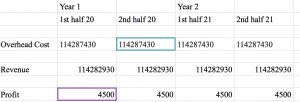Ten things I would do for the next presentation
- I didn’t present this time but I will present in the next presentation. I will practice my part several times so that I am prepared.
- I will make sure that our presentation is cohesive. There was some conflicting information in the presentation because of miscommunication between group members
- We will have a little bit more of a business plan for next time
- We will develop more FAQs that people could possibly ask
- We will include less background information and get right into the venture itself
- We will try to pack more data into the presentation instead of just including it in the backup slides
- I will try to be more confident when answering the questions
- I will try to make better eye contact when speaking
- I will try to answer more of the questions
- We will try to get everybody to speak
Does your work require IRB approvals? If yes articulate your IRB strategy.
Our work requires IRB approvals. We need IRB approval because our work requires human subjects and research. We have created a sweet potato cake and are now creating other products, and we will want to give them to children to taste test. Also, we will give them to children to decrease the rate of malnutrition. We will be using interventions and interaction with these children. Our project involves minimal risk – the children eating the cakes are not doing anything out of the ordinary that is much different from their daily lives. The only potential harm is consuming too many because then the child would be overdosing on vitamins, and we have been discussing this at length to reduce this risk. Our research group is a vulnerable population because they are minors so we will have to get parental consent because the children ages 2-5 can not provide consent themselves. This is also important to Sierra Leonean culture because of the importance of the mother and her opinion. We will include the fact that we are working with vulnerable populations in our IRB proposal. There is an International Ethics Review Board in Sierra Leone and we will have to get a verbal approval from them in order to do our work. They will not sign a paper but will verbally “okay” it. I believe that our project might be exempt, but if it is not exempt, it will be expedited. There is no reason for a full review by the entire IRB.
Develop a logic model.
Situation: Hidden hunger is killing children in Sierra Leone. The damage that micronutrient deficiencies cause is reversible between ages 2 and 5.
Priorities: We want to provide Sierra Leonean children with a nutritional supplement that will reduce malnutrition rates and improve health.
Inputs: business and engineering knowledge, planning time, money
Outputs:
We will reach bakeries to partner with, nutritionists, food scientists, children, and mothers.
We will develop a nutritional supplement (sweet potato cake) to children ages 2-5 that will include all of their required daily nutrients.
We will educate staff in the facility and women selling the cakes in the market.
We will create a product, a business plan, and a community network.
Impact
We will create knowledge about the importance of micronutrients and skills in baking the muffin.
We will give children access to a food that will improve their nutrition and thus their overall health.
We will reduce the rate of malnutrition and improve child and adult health.





